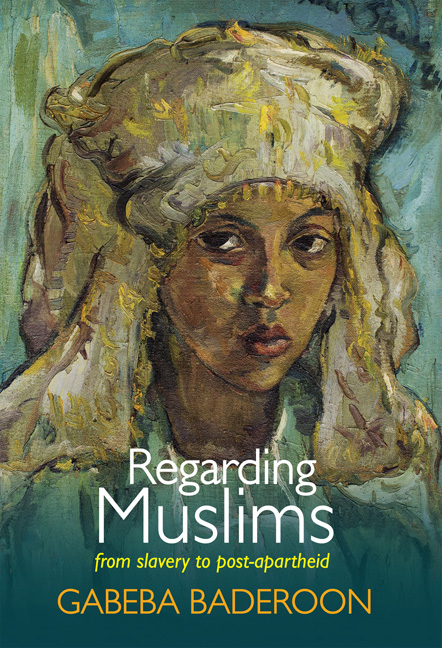Book contents
- Frontmatter
- Contents
- List of illustrations
- Acknowledgements
- Foreword
- Introduction: Beginnings in South Africa
- Chapter 1 Ambiguous Visibility: Muslims and the making of visuality
- Chapter 2 “Kitchen Language”: Muslims and the culture of food
- Chapter 3 “The Sea Inside Us”: Parallel journeys in the African oceans
- Chapter 4 “Sexual Geographies of the Cape”: Slavery, race and sexual violence
- Chapter 5 Regarding Muslims: Pagad, masked men and veiled women
- Chapter 6 “The Trees Sway North-North-East”: Post-apartheid visions of Islam
- Conclusion
- Notes
- Glossary
- Bibliography
- Index
- Plate section
- Frontmatter
- Contents
- List of illustrations
- Acknowledgements
- Foreword
- Introduction: Beginnings in South Africa
- Chapter 1 Ambiguous Visibility: Muslims and the making of visuality
- Chapter 2 “Kitchen Language”: Muslims and the culture of food
- Chapter 3 “The Sea Inside Us”: Parallel journeys in the African oceans
- Chapter 4 “Sexual Geographies of the Cape”: Slavery, race and sexual violence
- Chapter 5 Regarding Muslims: Pagad, masked men and veiled women
- Chapter 6 “The Trees Sway North-North-East”: Post-apartheid visions of Islam
- Conclusion
- Notes
- Glossary
- Bibliography
- Index
- Plate section
Summary
The whole is always the untrue.
– Theodor Adorno, quoted in Hussein (2002: 233)The photographs of Pagad on the front pages of South African newspapers in August 1996 created a shock of recognition by overturning the picturesque mode of representing Muslims and reviving the nineteenth century image of the “fanatical” Oriental running “amok”. Images of Pagad articulated both a new and an old vision of Muslims and intersected with an international idiom focused on militancy and alienation. It was this oscillation between the placid and the fanatical that prompted the writing of Regarding Muslims.
In this book, I have explored the long fascination with images of Muslims in South Africa. I have argued that the figure of the picturesque Muslim evokes not only what is to be remembered, but what to be forgotten – in fact, reliance on the picturesque or “kitsch” portrayal of Muslims, involving sentimental and reassuring tropes, requires the forgetting of certain histories.
This is manifested in a fascination with picturesque Muslim figures, at the same time that the violence of slavery has been erased, signs of which remain in popular culture in images that allude obliquely to slavery. I have argued that the charged play of visibility and invisibility in these images of Muslims in the popular realm holds a revealing diagnostic power.
Toni Morrison showed that the weighted tone of black characters in white American literature signalled subsumed meanings of race in the US, in which “black people ignite critical moments of discovery, change or emphasis in literature not written by them” (1992: viii). Similarly, I have taken a lesson from the recurring image of the picturesque Muslim in popular culture and argue that this offers a diagnostic tool for eliciting a part of history that has disappeared – but not disappeared. The anxiety of remembering slavery is refracted in popular culture through a focus on festivity, beauty, submissiveness and placid religious observance. Where Morrison identified a “pervasive use of black images” in literature that contemplates the meaning of freedom and individuality in a context of systemic violence and enslavement (1992: x), I find that the most compelling themes in the South African instances I have analysed are belonging and indigeneity. “Visibility” in the picturesque mode literally makes Muslims disappear – but reappear as reassuring objects that allay the anxiety of belonging for the colonial gaze.
- Type
- Chapter
- Information
- Regarding Muslimsfrom slavery to post-apartheid, pp. 153 - 160Publisher: Wits University PressPrint publication year: 2014



